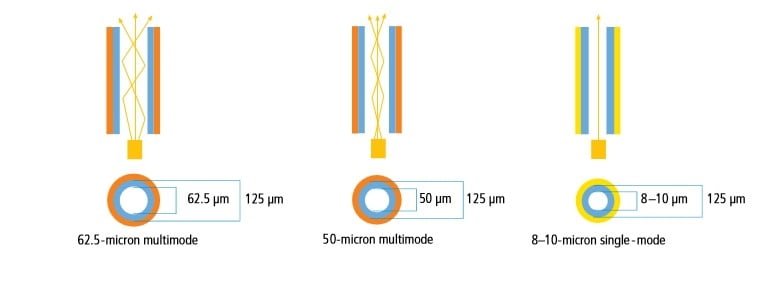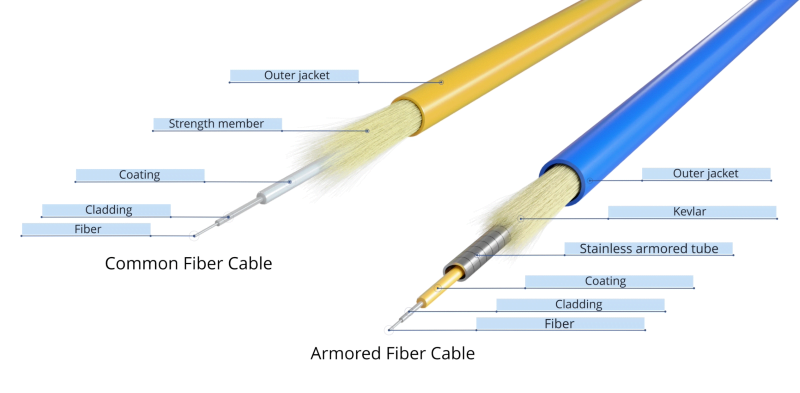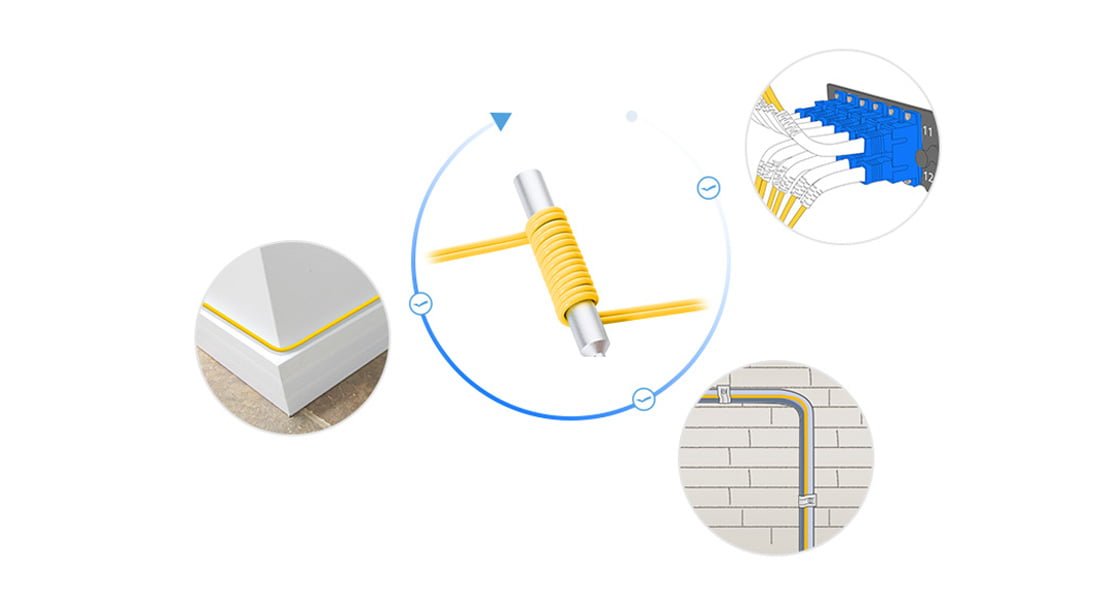What Is Fiber Patch Cord?
Fiber Patch Cord or Fiber Optic Patch Cable or Fiber Optic jumper cables is a fiber-optic cable capped at either end with connectors that allow it to be rapidly and conveniently connected to CATV, an optical switch or other telecommunication equipment. Its thick layer of protection is used to connect the optical transmitter, receiver, and the terminal box. This is known as “interconnect-style cabling”
Fiber optic patch cords are characterized by:
Low insertion loss;
High return loss;
Good repeatability;
Good interchange;
Excellent environmental adaptability.Construction of fiber optic patch cord
A fiber optic patch cord is constructed from a core with a high refractive index, surrounded by a coating with a low refractive index, that is strengthened by aramid yarns and surrounded by a protective jacket. Transparency of the core permits transmission of optic signals with little loss over great distances. The coating’s low refractive index reflects light back into the core, minimizing signal loss. The protective aramid yarns and outer jacket minimizes physical damage to the core and coating.
Size
Ordinary cables measure 125 µm in diameter (a strand of human hair is about 100 µm). The inner diameter measures 9 µm for single-mode cables, and 50 / 62.5 µm for multi-mode cables.
The development of “reduced bend radius” fiber in the mid-2000s, enabled a trend towards smaller cables. Each unit of diameter reduction in a round cable, produces a disproportionate corresponding reduction in the space the cable occupies.
Classification
Patch cords are classified by transmission medium (long or short distance), by connector construction and by construction of the connector’s inserted core cover.
Transmission medium
Single-mode fiber is generally yellow, with a blue connector, and a longer transmission distance. Multi-mode fiber is generally orange or grey, with a cream or black connector, and a shorter transmission distance.
Connector construction
Connector design standards include FC, SC, ST, LC, MTRJ, MPO, MU, SMA, FDDI, E2000, DIN4, and D4. Cables are classified by the connectors on either end of the cable; some of the most common cable configurations include FC-FC, FC-SC, FC-LC, FC-ST, SC-SC, and SC-ST.
Inserted core cover
The connector’s inserted core cover conforms to APC, UPC, or PC configuration. An UPC inserted core cover is flat and is used in SARFT and early CATV. An APC connector’s inserted core cover is oblique (about 30°, ±5°). To reduce the back reflection of a connector, UPC polish is used. Industry standard is a minimum of −40 dB for PC back reflection measurement and −50 dB for UPC back reflection measurement. If even less back reflection is required, an APC might be necessary. An APC connector has an 8º angle cut into the ferrule. These connectors are identifiable by their green color. An APC polished connector has an Industry Standard Minimum of −60 dB measurement. APC fiber ends have low back reflection even when disconnected.
Armored fiber patch cord
Armored fiber optic patch cord uses a flexible stainless steel tube inside the outer jacket as the armor to protect the fiber glass inside. It retains all the features of standard patch cord, but is much stronger. It will not get damaged even if stepped by an adult and they are rodent-resistant.
Bend insensitive fiber optic patch cord
Bend insensitive fiber patch cord is widely used in FTTH. The fiber is not sensitive to stress and bending. Singlemode bend insensitive fibers include G657A1, G657A2, G657B2, and G657B3.
Mode conditioning patch cord
A mode conditioning patch cord is required where Gigabit 1000 Base-LX routers and switches are installed into existing multimode cable plants. The transceiver modules launch only single-mode 1300 nm signals but the existing network is built with multimode cables.
A single-mode laser launch into the center of a multimode fiber can generate multiple signals that confuse the receiver at the other end of the fiber. These multiple signals, caused by Differential Mode Delay (DMD) effects, limit the system distance lengths for operating Gigabit Ethernet. Mode Conditioning Patch Cord eliminates these multiple signals by aligning the single-mode launch away from the center of a multimode fiber core. This offset launch creates a transmitted signal that is similar to a typical multimode light-emitting diode (LED) launches.
Fiber patch cord is seeing broad adoption in applications spanning telecommunication and data communication. With numerous business and enterprise reaping great benefits from it, fiber patch cord represents by far the most sufficient and prevalent bandwidth feeder. As those gigabit-capable networks proliferate, the fueling capacity and speed quest further drive fiber patch cord deployment. When facing various fiber patch cord types on the market, how can we make a valid choice? Some basic understanding of the fiber patch cord would be helpful.
What Is Fiber Patch Cord?
Fiber patch cord, often called fiber patch cable, fiber jumper, or fiber patch lead, is a length of fiber cable that terminated with fiber optic connectors (LC, SC, MTRJ, ST and etc.) at each end. The connectors allow fiber optic patch cord to be rapidly connected to an optical switch or other telecommunications/computer device. Fiber jumper is a key player for indoor use, like in server rooms or in data centers. Featuring excellent reliability, superior adaptability, and improved security, fiber patch cord has ranked the best choice for applications where conventional copper cables fail to reach.
What Are Fiber Patch Cord Types and How to Choose?
Fiber optic patch cords in the market now have various types. We mainly divide them into common fiber patch cord types and special patch cord types in this explanation.
Common Types of Fiber Patch Cords
Based on different specifications and standards, the common fiber patch cords can be categorified from the perspective of fiber cable mode, transmission mode, jacket type, connector type, and polishing type.
Fiber Cable Mode: Single Mode or Multimode
The mode of fiber patch cables indicates how light beams travel within the fiber. There are two fiber cable modes: single mode and multimode.

Figure 1: Single mode vs multimode
Single mode fiber patch lead only allows one mode of light to pass along its length with a very thin diameter of 8-10 microns, thus it can carry signals at much higher speeds with lower attenuation. Single mode fiber has two varieties: OS1 and OS2, which are different in construction and application. In Comparison Between OS1 and OS2 SMF Cables, the differences between OS1 and OS2 are illustrated. In general, OS1 and OS2 are both applicable for long-haul transmission but OS2 is more suitable for long-haul transmission by offering better performance with fewer losses.
The core of the multimode fiber patch cord is bigger, typically 50 or 62.5 microns, which enables multiple light modes to be transmitted. It comes in five varieties supporting different transmission rates or distances: 62.5-micron OM1, 50-micron OM2, 50-micron OM3, 50-micron OM4, and 50-micron OM5, which can be differentiated by standard jacket colors. Since multiple light paths travel down the cable, the distance which multimode fiber jumpers can reach is usually short. For short-distance transmission within a building or campus, multimode fiber patch cords are the best-suited type. You can get more information about multimode patch cables in Multimode Fiber Types: OM1 vs OM2 vs OM3 vs OM4 vs OM5.
Number of Fiber Strands: Simplex or Duplex
According to the number of fiber strands, there are simplex and duplex fiber patch cord. As shown in Figure 2, simplex fiber patch cord contains one single strand of fiber with one simplex connector on each end. It can be linked with a pair of BiDi transceiver modules featuring with one port. Whereas duplex fiber patch cord consists of two strands of glass or plastic with one duplex connector (or considered as two simplex connectors). It is often linked with common transceivers or dual fiber BiDi transceivers.

Figure 2: Simplex vs duplex fiber patch cord
Jacket Type: PVC or LSZH
PVC and LSZH are used to describe the common jacket material of fiber patch cord. Fiber patch cables covered with PVC jacket are flexible at normal installation temperatures. Compared with PVC patch cords, LSZH patch cords are more rigid and less flexible but they contain the flame retardant compound that doesn’t emit toxic fumes if it burns. PVC fiber optic patch cord is usually used for indoor applications such as horizontal runs from the wiring center. While LSZH cable is used in unventilated areas exposed to public, such as subways and tunnels and also used for rooms that are not easy to get out quickly.
Connector Type: LC, SC, ST or Others
There are many connector types used in fiber patch cables such as LC, SC, ST, MTP or MPO listed in this article How Many Fiber Connector Types Do You Know? Aside from these connectors, there is a latest connector design called MDC connector, which enables the highest achievable connector density by delivering a 3X advantage over a standard LC connector. The different connector types are to plug into different interfaces, so you’d better affirm the interface type of the devices you are using the first time.
If divided by the criteria whether the connector on each side is the same, they can be divided into same-connector type fiber patch cord and hybrid fiber patch cord. Fiber patch cords that have the same type of connector on both ends includes LC to LC fiber patch cord, SC to SC fiber patch cord and etc. While hybrid fiber patch cord has different connectors on each end, like fiber patch cord LC to SC. If the port type of devices on both sides are the same, you can choose the same-connector type fiber patch cord, or you need choose the hybrid one.
Polishing Type: PC, UPC or APC
Fiber optic connectors are designed and polished to different shapes to minimize back reflection, which is particularly important in single mode applications. According to this connector polish types, there are PC, UPC, and APC fiber patch cords. This post PC vs UPC vs APC Connector: Selecting the Right Fiber Connector Type presents the difference of PC, UPC, and APC. Nowadays PC polish type has been replaced by UPC type. Whether you choose UPC or APC depends on your actual application. Since APC provides less insertion loss than UPC, the APC fiber patch cables are more applicable for high bandwidth applications and long-distance links, such as FTTx, passive optical network (PON) and wavelength division multiplex (WDM). Whereas UPC fiber patch cords apply to optical systems that are less sensitive to insertion loss such as digital TV and telephony.

Figure 3: PC, UPC, and APC polish type
Special Types of Fiber Patch Cords
Fiber patch cord is evolving to keep pace with the ever-increasing bandwidth needs. Some specially designed fiber patch cables emerge to fit different application needs. Knowing the available options would save us significant time and money. Here are some special fiber optic patch cords for use in certain circumstances.
Armored Fiber Patch Cord
Armored fiber patch cord retains all the features of the common fiber patch cord. The main difference between armored fiber patch cable and common fiber patch cord is that armored fiber jumpers are designed with a stainless armored tube inside the jacket and outside the optical fiber as you can see in figure 4. This design enables armored fiber patch cords strong enough to be anti-rodent and resist the steps by an adult. Strong as it is, the armored fiber patch cord is actually as flexible as standard fiber optic patch cord and can be bent randomly.

Figure 4: Common fiber cable vs armored fiber cord
Bend Insensitive Fiber Patch Cord
Bend insensitive fiber patch cable is highly resistant to bend related damage and loss. It has a small cable bending radius and prevents additional bend losses by innovative core design and enhanced low macro-bending sensitivity. Bend insensitive fiber patch cord is made to support data center and FTTH applications, and high-density cabling that has to wrap and take tight corners. Click to see why you need bend insensitive fiber patch cables.

Figure 5: Bend insensitive fiber patch cord application
Mode Conditioning Fiber Patch Cord
This special fiber patch cord is a duplex multimode patch cable that has a small length of single mode fiber at the start of the transmission length. It is designed to solve the technical issue involved in using single mode equipment on the existing multimode cable plant. Mode conditioning fiber patch cord aims to drive the distance of installed fiber plant beyond its original intended applications, as well as to improve data signal quality. For more information about using tips of mode conditioning patch cord in typical cases, please refer to Mode Conditioning Patch Cord Utilized in 1/10 Gigabit Ethernet Applications.

Figure 6: Mode conditioning fiber patch cord
Low Insertion Loss Fiber Patch Cord
The low insertion loss fiber patch cords adopting LL technology feature lower connector insertion loss compared with the common fiber patch cords, though it bears many similarities with common patch cable judged only by appearance. For example, the industry-standard insertion loss of common fiber connector is 0.75dB, but for low loss fiber patch cord, it can be 0.2dB or lower. This type of fiber patch cords is often used for applications where the amount of attenuation loss is a crucial element. With reduced attenuation, they are able to expand the network’s reach for long-haul applications.
Uniboot Fiber Patch Cord
Terminated with specially designed LC uniboot connectors, uniboot fiber patch cable integrates two fibers in a single cable, thus delivering significantly more advantages in high-density cabling environments. It cuts down the cable count up to 50% compared with the standard LC cables and represents the best fit for places where space is a concern, which is the main advantage of it.
Figure 7: Standard LC cable vs uniboot LC cable
There is one type of uniboot fiber patch cord called switchable uniboot fiber patch cord, which is designed to switch the polarity of the fibers only by maneuvering the connectors without the need of a special tool. Such design avoids potential troubles that may be caused by re-terminating connectors, which attributes to more efficient cable management.

Figure 8: Polarity reverse of switchable uniboot LC cable
[ux_products_list cat=”38″ products=”100″]